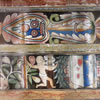| Crathes Castle, sundial, heraldic panels, weather vanes, doocot etc |
|---|

Crathes is particularly known for its ceiling paintings. Photography is not allowed in the castle but there are excellent photographs in the RCAHMS "canmore" database see: http://canmore.rcahms.gov.uk/en/site/36693/digital_images/crathes+castle/ . |
| Delgatie Castle |

Delgatie Castle dates from about 1030. The main tower dates from the 1100s while its final extension with the battlement walk above the string course was completed in 1579. Both wings were added in 1743. |
| Delgatie, Maries Bower |

A text work painted on the ceiling beams in a room reputed to have provided lodging for Mary Queen of Scots, this painting confuses me as the text is the same as 2 stanzas in the poem "Kilmeny" by James Hogg 1770–1835 (it is a part of her prophetic vision during her stay among the fairies) . I admit my ignorance, I do not know if the ceiling painting is in fact a modern work or if this part of the poem was copied by Hogg from an earlier source. More Information |
| The 1592 Ceiling, Delgatie |

This ceiling is decorated on the beams only, mostly with a long inscription on the sides, with decorative work on the underside. |
| The 1597 Ceiling, Delgatie |

One of the most important surviving 16th century painted ceilings in Scotland The iconography has interesting comparisons to the much earlier Aberdeen Bestiary and even earlier Pictish sculpture. |
This content was submitted by external contributors and does not necessarily reflect the views of the University of Aberdeen.
